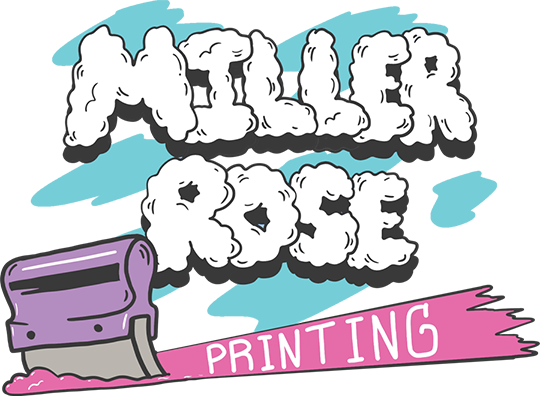dtf vs dtg printing
Share
DTF vs. DTG Printing
January 14, 2024 | MillerRose Printing
Direct-to-film (DTF) has emerged as a prominent printing process, rivaling Direct-to-Garment (DTG) printing in the realm of clothing customization. For apparel designers, creators, and retailers, a clear understanding of the distinctions between these methods can translate to enhanced profitability.
What is Direct-to-Film (DTF) Printing? Direct-to-film (DTF) printing is a method of customizing clothing by imprinting a design onto a specialized film using a high-quality inkjet printer. Subsequently, the film is applied to the fabric and subjected to heat pressing, facilitating the transfer of ink onto the material.
The key advantages of DTF include:
- Versatility: Performs well on various materials such as cotton, poly-cotton blends, and polyester.
- High-Quality Results: Yields vibrant and crisp designs comparable to traditional screen printing.
- Durability: The printed designs adhere to the fabric, ensuring a longer lifespan.
What is Direct-to-Garment (DTG) Printing? Direct-to-Garment (DTG) printing involves customizing apparel by directly applying ink to the fabric using a specially designed inkjet printer. It has gained popularity as an alternative to traditional screen printing.
The main benefits of DTG encompass:
- Highly Detailed Images: Ideal for intricate designs with multiple colors.
- Soft Feel: Water-based inks are absorbed into the fabric, maintaining a soft texture.
- Fewer Production Steps: Requires fewer steps to complete a project.
Comparing DTF vs DTG:
-
Color Vibrance:
- DTF transfer prints excel in color vibrancy, saturation, and accuracy, while DTG printing may face challenges in achieving vivid colors.
-
Durability:
- Both methods can produce long-lasting prints, with DTF printing tending to offer greater durability due to the heat bonding process.
-
Feel:
- DTG produces a softer texture, whereas DTF-printed garments may exhibit a smooth, glossy finish.
-
Fabric Types:
- DTF is versatile across a wide range of fabrics, including cotton, polyester, and blends, while DTG is best suited for natural-fiber products like cotton.
-
Printing Speed:
- DTF printing is typically faster, with DTG facing longer curing times of up to 15 minutes.
-
Printing Ease:
- DTF is simpler than DTG, requiring only heat pressing after the ink is printed onto the transfer. DTG involves pre-treatment and post-printing heat curing.
-
Versatility:
- DTF is more versatile, applicable to various fabrics and apparel types, offering unique print placements that DTG cannot match.
-
Cost:
- DTF tends to be less expensive than DTG, considering factors like consumables, maintenance, and staff training.
Which is Best: DTF or DTG? While both DTF and DTG can yield excellent results, the choice depends on project requirements, garment considerations, and budget constraints. However, DTF is often recommended as the superior option due to its cost-effectiveness, versatility, and comparable feel to DTG. Whether you're an individual creator or a small business, Direct-to-Film printing presents significant advantages over Direct-to-Garment. For detailed insights tailored to your project, feel free to reach out to us.
